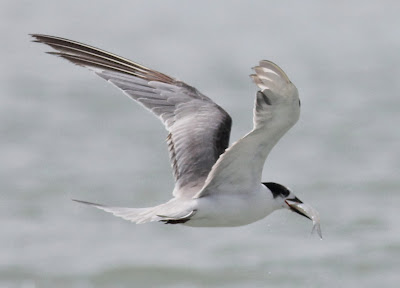It has been well written that the identification between Whiskered Terns (Ch. hybridus) and White-Winged Terns (Ch. Leucopterus) during winter/outside its breeding season has been a major headache to the recreational birders / lay people. In fact some articles to some extent has declared that the differences between the two terns species are almost inseparable in the field during winter. Numerous research/articles have thus been written seeking reliable markers/identification patterns/plumages of juvenile, first winter and adult winter birds but the conclusions have always been somewhat inconsistent. For example it was reported that Whiskered Terns have longer bill as compared to White-Winged terns but that was only true for males as females Whiskered Terns were reported to have similar shorter and stockier bill as White Winged Terns. Similarly White-Winged Terns are also reported to retain some black patches/feathers on its body side while molting from breeding to winter plumages. Then the body length of a Whiskered Tern was reportedly to be just about 2cm longer than a White-Winged Tern!
So then how does a lay-person able to differentiate or at least identify them in the field? There are two possible easy identification areas which you could use to identify between Whiskered terns and White-Winged Terns. The two field marks which you can look out for are i) its head patterns and ii) the feather colors near its body areas. The previous post has shown the photos of the Whiskered Terns so this time it will be the White-Winged Tern (Ch. Leucopterus).
In the head pattern of a White-Winged tern, the black patch behind it eyes should be round, the rounder the patch the more conclusive it would be. The black patch would then link to its black crown (with some white flecks in juvenile) forming like a pair of head phones. The second thing is that the body side of a Whiskered Tern has more black smudges than a White-Winged tern. Here are some of the possible photos of White-Winged Terns.
A flock of incoming White-Winged terns.
Here are more recent photos (Feb 2015) below:
Here are some of the photos of terns which i think could also possibly be a White-Winged Tern or is it really? Have a look and you can decide for yourself.
Note: Juvenile Whiskered Terns apparently also "wears" a headphone !
Whatever stuff which have been mentioned here only provided you with some basic pointers as reference. To be thorough there are other jizz which you can compare and observe - for example its wing colors, rump, tail, flight patterns etc. An expert once told me that to learn and obtain a better understanding of the jizz of these terns, one just need to go out to the field and study them thoroughly.
HAVE FUN !


























































